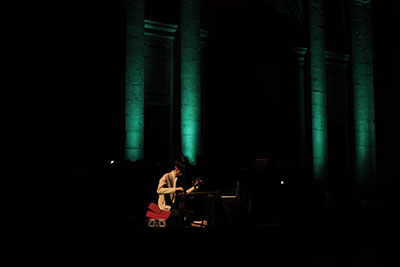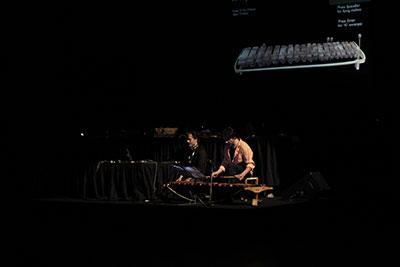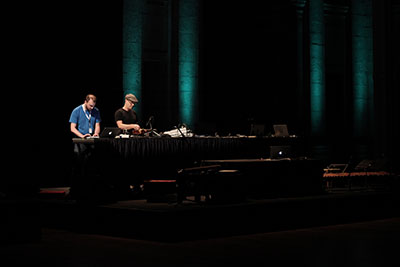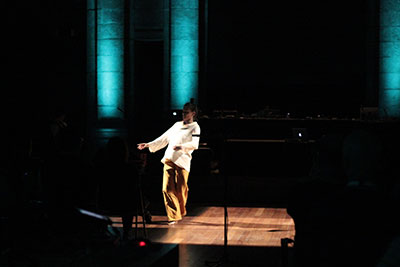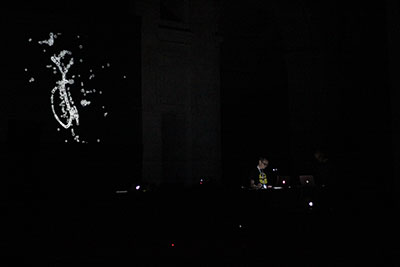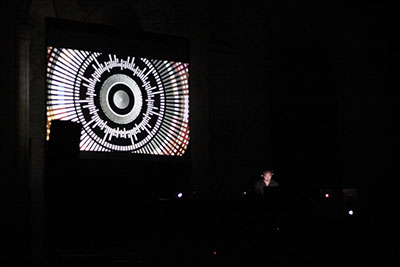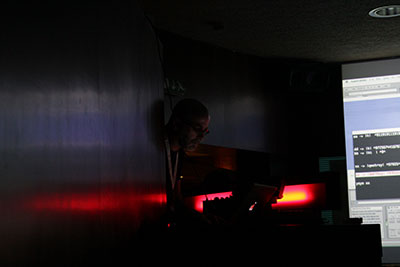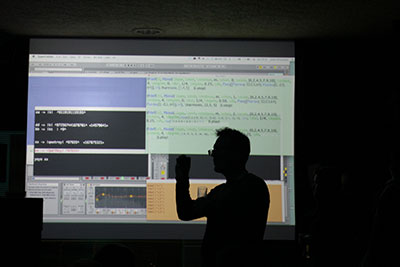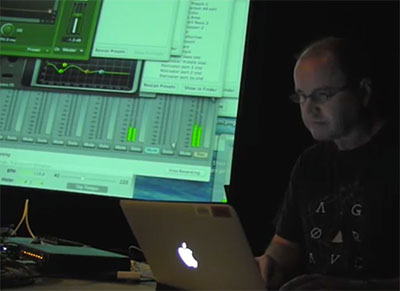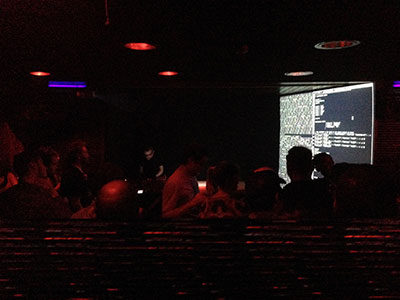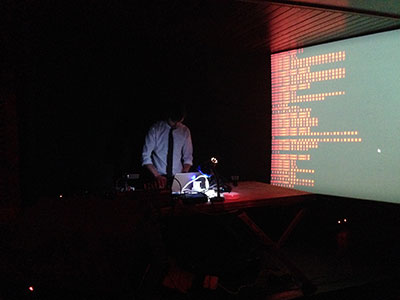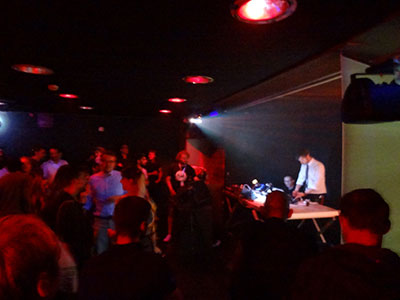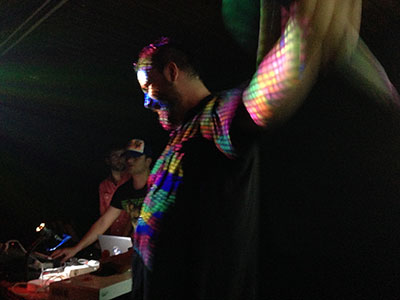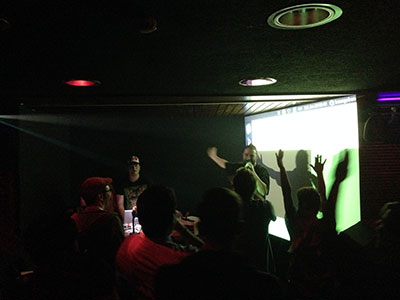Proceedings
xCoAx 2014: Proceedings of the Second Conference on Computation, Communication, Aesthetics and X.
- Edited by Miguel Carvalhais & Mario Verdicchio;
- ISBN: 978-989-746-036-4;
- 561 pages.
xCoAx 2014: Proceedings of the Second Conference on Computation, Communication, Aesthetics and X.
The Journal of Science and Technology of the Arts, published by the Portuguese Catholic University in Porto, has released a special issue with a selected set of extended papers from the xCoAx 2014 conference. The issue includes works from Victoria Bradbury; Hanna Schraffenberger & Edwin van der Heide; ginger coons; Luísa Ribas; Monty Adkins; Arne Eigenfeldt, Miles Thorogood, Jim Bizzocchi & Philippe Pasquier; Andres Wanner; Adriana Sa, Baptiste Caramiaux & Atau Tanaka; and José Alberto Gomes et al.
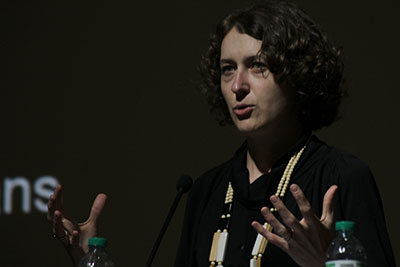
Digital cultural production oscillates between singular instances and massive scale occurrences, the individual and the collective, unique and generic, where such tensions are constitutive, as paradoxes, of modes of production and operation of subjectivity today. These tensions are exemplified in art work, and are sustained by computational machines, some of which are database management systems. Generic here relates to measurement, seriality, similarity, and relationality, where the operation of relating itself contributes to the new articulations of the singular and multiple. This talk discusses such relationality in computational cultural forms. The position of the subject that Kittler claimed to be occupied by the Turing machine, is in fact constructed in more complex ways, by computational ensembles that contribute to the maintenance of the subject, rather than replacing it completely. The subject is produced not through an exercise in writing but through the relationality of data which, in the example of an art project, such as Curating YouTube, handles singularities and establishes relations between them as a multiple or as a ragged manifold. It is somewhere in this computational maintenance of the operationalised singular and multiple and the movement between them that the new kind of the subject arises. I explore the generic, a number of art projects on YouTube and curatorial tools, and NoSQL databases to arrive at an understanding of the new forms of multiplicity and relationality that cut to the core of the changing conditions of possibility of the subject.

This paper uses an analogy of ventriloquism to reflect on the roles of code, coding artist, and visitor in participatory new media artworks. Ways in which theorists and practitioners have viewed code and speech are considered while two of the author’s artworks, Toast and Ventriloquisms for Fun and Profit, are used as case studies. Here, the projects are described and insights that emerged from their implementation are proposed as results. Throughout the text, ventriloquism diagrams are used to illustrate possibilities for directional transmission of speech that occur in the artworks being discussed.
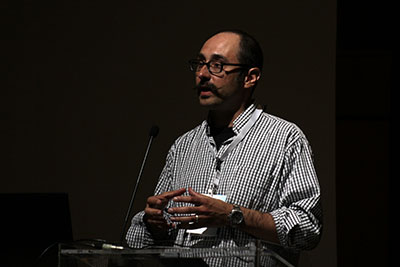
A glitch is an unpremeditated result of a digital protocol, making visible technology by its failures. Both practitioners and scholars have explored this phenomenon creatively and theoretically.
This paper provides an overview on glitch literature and examines definitions and motivations for glitch art, grounded in a more established discourse on the role of the error in art. The Artificial Intelligence notion of emergence will be consulted, to offer a model for phenomena arising without being prescribed.
The paper applies these concepts from literature to a practical line of inquiry, describing two mechanical drawing machines of the author, which draw their aesthetics from imperfection. Peirce’s semiotics is consulted to establish a distinctive framework situating both the mechanical patterns and digital glitches.
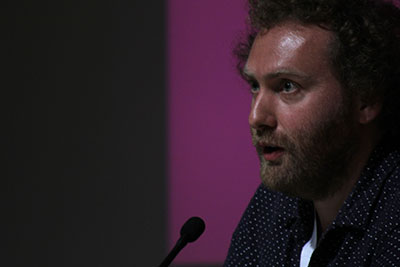
Creative coding has goals, methods and tools that distinguish it from other forms of programming practice. A number of creative coding practitioners regularly engage with complex systems in creative applications, such as neural networks, genetic evolution, ecosystems and reaction-diffusion equations. Such systems are conceptually opaque and hard to manipulate, but we know little about the ways in which creative coders handle them. In this paper we present findings from a survey of creative coders regarding how they deal with complexity in their work. We discuss four issues of interest: time-demands of specific activities; sources of knowledge and approaches to problem solving; approaches to exploration; and information-seeking versus intuitive styles of working. Our results provide an initial characterisation of creative coding strategies and suggest how tools could be better adapted to their needs.
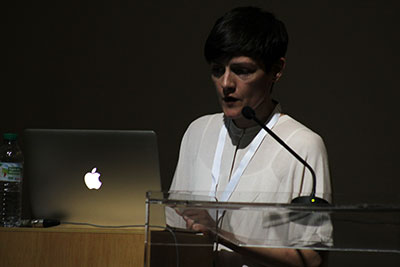
This paper addresses the study of digital computational systems as aesthetic artifacts seeking to provide instruments for their analysis and critical understanding. Implied in this view, is the need to combine complementary perspectives considering both their specificity as digital computational (software-driven) systems and their different aesthetic intents and experiences. This approach also entails articulating the viewpoint of their creation or poetics with the viewpoint of their experience or aesthetics. To this end, this paper discusses concepts and frameworks that not only argue on the distinctive processual nature of these systems, but also stress the interdependency of views on their principles, mechanics and experience.
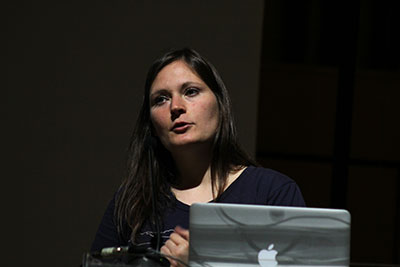
What is augmented in Augmented Reality (AR)? This fundamental question has received surprisingly little attention in AR research. In this paper, we review existing views and show how little consensus there is on the topic. Subsequently, we approach the question from a theoretical and technology-independent perspective that focuses on the relationships between the virtual and the real. We consider both spatial as well as content-based augmentations and distinguish between augmented environments, augmented objects, augmented humans, augmented content and augmented perception. We discuss our findings and suggest possible future directions, such as research into multimodal and crossmodal AR.
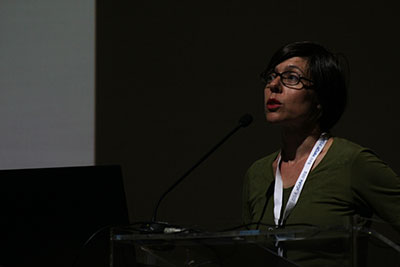
Although in public common sense and institutional circuits a notion prevails that dance only fulfils its nature as a live art form, several practitioners have been exploring remarkable and creative endeavours that defy that understanding. Furthermore, stop animation, data processing and motion capture technologies enable choreography to expand beyond the human body, challenging the reasoning that dance must have a corporeal manifestation. While theoretical discussions define dance as a system that combines various elements, they also emphasize the role of the performer to represent the discipline. Looking at early experiences that have transferred theatre performance to the cinema and new media dances that encourage sensual human-computer interactions, this article reviews how choreographers resolve the challenges of migration and keep the body as a central medium to articulate artistic knowledge and identity.
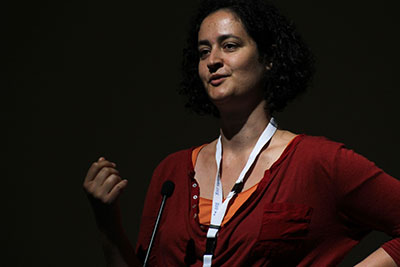
This method paper explores the creation of a pattern with parallel curves on a machine knitted tube in the frame of an artistic research project. Using modular arithmetic and the software Processing, the initially empirically generated pattern is analyzed and simulated. The results are then used in order to create intentional iterations of the parallel curve pattern, determining the winding of the yarn for dyeing and the lengths of the yarn strands. The paper draws a connection from a craft based technique (knitting) to mathematics.

The following paper presents a robotic system that makes the process of crystal growth tangible. The background of this work are the early experiments from Gordon Pask on building a chemical computer as a learning system and my own interest in brain plasticity. With the help of software simulation the idea of a learning structure that grows and modifies its own perception of the environment is illustrated. The robotic implementation of the growth process is a first step towards making such a process tangible.
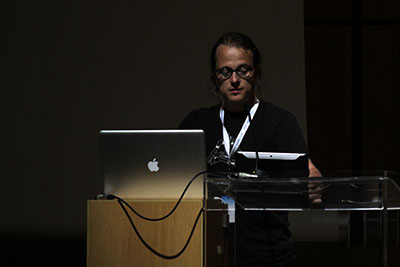
Internet scammers use fictional narratives to gain the trust of potential victims. These narratives are often pre-scripted, get send out by individual scammers or scam-groups and are often copied and reused by other scam-gangs. Vigilante online communities of scam baiters try to jam the practices of these Internet scammers by using similar social engineering techniques to hook the scammers into a story and consequently interrupt their workflow. In this paper, through examples, I want to take a closer look at the scammers working methods and focus on two different strategies on how scambaiters use to approach scammers.
The ubiquity of data has spawned the emergence of many forms of data-driven artwork ranging from digital to physical pieces and their perceived intersection. This paper presents novel techniques for interaction design, aesthetics and technical implementation in the creation of participatory data-driven art objects. A subset of data-driven artwork is discussed, which covers data visualization art and data objects, both interactive and fixed, in order to place the authors’ work in context.
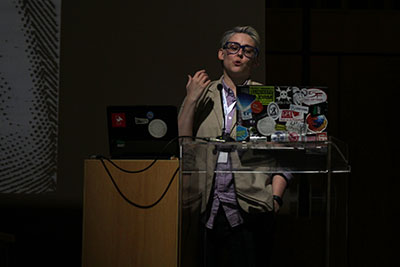
Anthropometry has historically involved “men of science” carefully measuring and noting down the dimensions of human bodies. Anthropometry is invoked to emphasize the importance of measuring the world at human scale, to achieve better economies of scale in making human-sized objects, and to make arguments and predictions about ideal states of humanity. This paper presents two projects which parse relationships between human bodies and measurement. “Scanning Hands” explores low-end 3D scanning as a probe and catalyst for discussion of the history of anthropometry as it relates to current 3D scanning practices. “Non-Standard Bodies,” an interactive wearable sculpture, tackles the imposition of remote standards on individual bodies. The goals of this paper are twofold: to explore systems of body measurement and their often-ignored ramifications; and to introduce an idea, the replacement of geography by standards, as a way of positioning and generalizing such measurement activities.
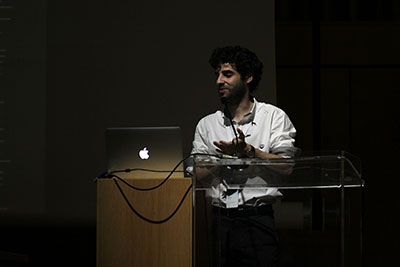
Nowadays, with the increase of publicly available information on economic and social matters, visualization has targeted such themes in order to promote transparency and raise awareness for the interested audience. This paper describes the design and implementation of an interactive visualization that displays the relations between Portuguese politicians with government positions and companies. The aim of this visualization is to create awareness of these relations, and by using a highly figurative approach, captivate the targeted audience. The visualization was able to gather interest from a broad audience and is available at pmcruz.com/eco.
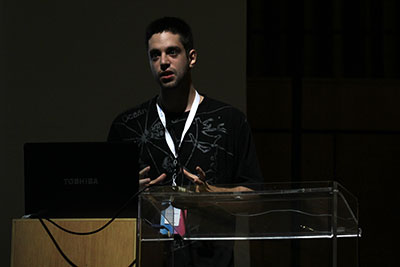
In this paper we provide an analysis of the participation of Humans and Computers in generating creative content, in the context of video games. More specifically, we analyze the role Procedural Content Generation can play as a means to empower designers to produce artifacts in a more efficient manner. We instantiate this analysis by focusing on the creation of creatures as an area that requires further research. In order to make this analysis, we surveyed the state of the art of Procedural Content Generation and Interactive Design Tools, all with the specific mindset of mapping techniques applied to generating of otherwise helping the production of game creatures and the Human participation involved in the process.
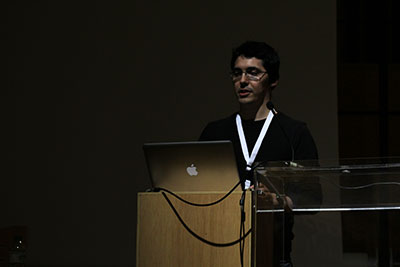
A video game player manages her attention according to the strategies developed and the challenges unveiled by the game system. The player does this to the best of her capabilities, developing different activities and performing alternative actions and actuations that may or may not be suggested or even imposed by the system.
This paper proposes four dimensions concerning player attention – time span, sensorial scope, frame, and actuation automation –, each being capable of expressing three alternative states – focused, defocused, unfocused –, and through which the game system manipulates the player’s affective state.
The variations that can be obtained by calculating all possible combinations, regarding these dimensions and their states, not only influence the affective states of the player, but also specify alternative characteristics regarding the nature of human interaction with the system, transpiring different gameplay dynamics.
Several researchers are dealing with colour, as a basic expressive element of cinema style. Nevertheless, the difficulty in analyzing a large number of images and describing their nature and characteristics in non subjective terms are still among the problems faced in this area.
This research presents a quantitative methodology that enables a systematic, objective and verifiable study of colour, by automatically obtaining accurate colour data from large amounts of images. The proposed scheme also allow us to find possible meanings when relating quantitative information obtained to the narrative content.
In order to test its efficiency, the methodological tool is applied to Career Girls (Mike Leigh, 1997). As a result, hue is found to follow an expressive program evolving within the narrative content, as it is closely linked to the different periods present in the film.
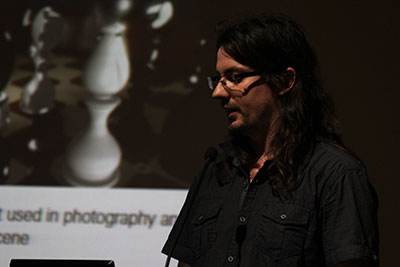
Gesture-based interaction in virtual environments often suffers from inaccurate depth estimations by the user. In particular, the usability of selection and manipulation tasks highly depends on correct distance judgments. Since haptic feedback is not available, the visual representation and the unambiguous interpretation of spatial configurations are fundamental aspects that influence the usability of gesture-based interaction in virtual environments. Reasons for incorrect judgment of egocentric depth in three-dimensional spaces are still partially unclear. We propose a different approach to overcome this issue. We introduce additional artificial depth cues, which are designed to improve the user’s understanding of spatial relations within virtual environments. Three visualizations of egocentric depth are introduced: a Depth-of-Field effect inspired by focus effects in photography, an effect called Color Perspective based on observations of the use of color in art, and the visualization of volumetric shadows using Crepuscular Rays.

The title of this contribution refers to a series of four sound-based artistic interventions realized in the crude landscape of the Finnish tundra. By analyzing the natural soundscape, digitally recreating constitutive elements thereof, and projecting those back into the environment using portable loudspeakers, a tilt of the natural setting was created, potentially altering and elevating the attendees’ experience of the scenery. The artistic concept and the practical approach as well as the diverse technologies used for the development and realization of the pieces are explained in detail.
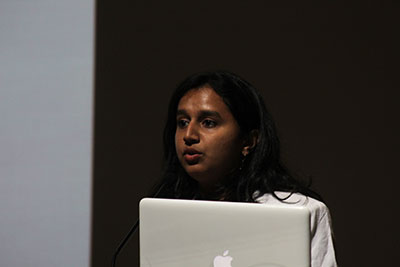
Performers of Hindustani Classical Music depend heavily on complex models of motion and movement to elaborate melodic ideas through hand gestures and motion metaphors. Despite advances in computational modeling of grammars that govern the elaboration of a raga, these systems run into difficulties because of the nature of pitch systems in computer programs and in performance. We elaborate the problems with trying to obtain the ideas in a flexible-pitch scheme like HCM through the means of a fixed-pitch scheme-like notation and computer music generation. In this paper, we present some experiments to study the effectiveness of a graphical notation scheme in HCM, sound tracing study and an analysis of the terminology used for ornaments – through which to understand motion in HCM. We plan to analyze them computationally to develop a formalism that would be more suitable to the nuances of HCM than the present schemes.

Contemplative interaction appears to be a misnomer; the term ‘interaction’ implies active engagement rather than quiet reflection. However, we are often engaged on multiple levels simultaneously, particularly inside complex systems. The bushwalk is an active engagement with the environment – a naturally occurring complex system – that occupies the body while the mind is adrift. Similarly, digital systems, such as games – artificially constructed complex systems – can induce a flow state in which actions become autonomic, occupying the mind while the body is at rest. This paper explores possible connections between these experiences, outlining a project that aims to blend the two via a technologically mediated bushwalk experience.

Video games are an ideal medium for creating a live-cinema experience because of their potential for cinematic narrative and their open structure. ‘Performing digital media’ as opposed to ’performing with digital media’ or using digital media in performance means to ‘play the media’ like a musical instrument as much as possible. This is to be able to control and finely nuance the audio-visual and kinetic data stream through live manipulation, and/or to respond instantly to this, on stage. This is, in a sense, to grant the performance an immediacy that belies remediation. This paper looks at recent instances in which as the media itself is being performed, a similar audiovisual contract to that of cinema is being entered into by an audience. Thus, the performance or live event itself, becomes a product of media technologies, yet is indistinctly unified with them.
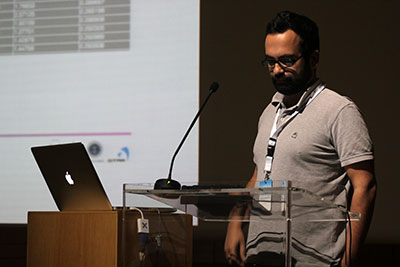
URB is a research project designed to collect and store raw data from soundscapes analysis. This paper presents a study about composing music using URB based on the analysis of work developed by several sound artists, focusing on the evaluation of their creative process and musical outcome. By comparing the processes and statements of each composer, the authors identified diverse systematic approaches to reinterpreting raw data provided by URB, raising questions about the musical outcomes vs original sound sources. Furthermore, some considerations are inferred about the artistic relevance of using URB to compose music.

The text reports a study, which draws upon methods from experimental psychology to inform audio-visual instrument design. The study aims at gleaning how an audio-visual mapping can produce a sense of causation, and simultaneously confound the actual cause and effect relationships. We call this a fungible audio-visual mapping. The participants in this study are shown a few audio-visual mapping prototypes. We collect quantitative and qualitative data on their sense of causation and their sense of understanding the cause-effect relationships. The study shows that a fungible mapping requires both synchronized and seemingly non-related components – sufficient complexity to be confusing. The sense of causation embraces the whole when the specific cause-effect concepts are inconclusive.
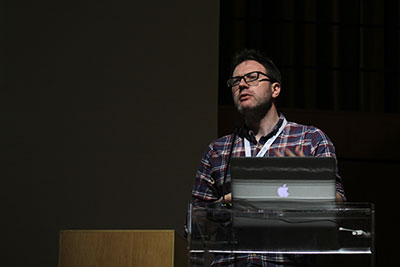
This paper proposes the notion of Nodalism as a means describing contemporary culture and of understanding my own creative practice in electronic music composition. It draws on theories and ideas from Boden, Lacan, Deleuze, Guatarri, and Gochenour et al to demonstrate how networks of ideas or connectionist neural models of cognitive behaviour can be used to contextualize, understand and become a creative tool for the creation of contemporary electronic music.

Metacreation is a contemporary approach to generative art, using tools and techniques from artificial intelligence, artificial life, and machine learning (themselves inspired by cognitive and life sciences) to develop software that is creative on its own. We present examples of metacreative art within the fields of music, sound art, the history of generative narrative, and discuss the open potential of the “open-documentary” as an immediate goal of metacreative video.
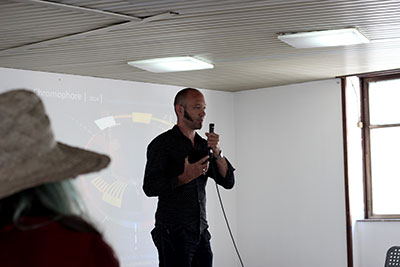
Chromophore is an audio-visual performance work that applies bi-directional communication between audio and visual systems, in real-time, to create colour-shape-sound modalities. Its visual system is formed using transformations and deformations of three-dimensional geometric primitives, super-ellipses and spherical harmonics. The dynamic surface textures of these transforming primitives are informed by data derived from audio analysis. Additionally performative MIDI control allows precise structural modulations and surface perturbations of the visual system to be further synchronised to sound.

Sonic Evocations is an electroacoustic work for solo Guqin and electronics, inspired by the poetic evocations and illustrations used to describe playing techniques in ancient Guqin tablatures. It aims to explore the performance application of the digitized Guqin hand gestures, traditionally metaphorically portrayed through movements found in nature. This work is the cumulative effort of the initial research in digitizing Guqin performance gestures, and gesture recognition using machine learning.
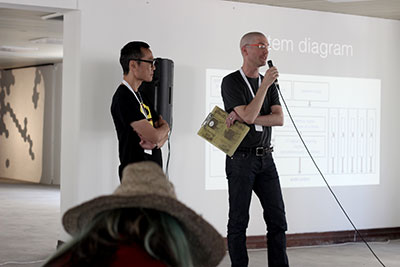
Xenoglossia/Leishmania is a structured audio-visual improvisation, utilizing live electronics and interactive animations. The musical and visual performances are highly interdependent, guided together through the actions of the performers, automated real-time analysis of the audio, and the exchange of networked messages between the audio and animation systems.

Quasicrystal Sound Field 1 is a live sound-art installation based on a new formulation of mathematical quasicrystals first published in 2009 by Grundland, Patera, Masakova and Dodgson. Quasicrystals are characterized by Aperiodic order. A structure with rotational symmetry but no translational symmetries. The particular algorithm, called the Quasicrystal Phase Function, is proposed for image sampling, but offers as well interesting possibilities for sound synthesis. This sound-work is a first example of bringing the algorithm as waveforms out in the open air.
The music of the Scottish School of Flower Arranging seeks to explore, by means of hand-made acoustic and digital tools, found objects and materials, an intimate sound world created from a few simple and basic elements which change slowly over time and which investigate asymmetry, materiality, irregularity, economy of means, and the emulation of natural processes. The name is derived from the Japanese zen-influenced practice of flower arranging and pays homage to similar socio-aesthetic activities such as the tea ceremony, where the qualities of restraint, careful placement of elements and detachment are highly valued, as are attributes of wabi-sabi such as the imperfect, the impermanent and the intimate.

Tactical Temporalities is a semi-improvised live coding performance that manipulates algorithmic descriptions of musical processes in the context of an Algorave setting. The work employs algorithms developed through research into musically salient computational processes and insights from studies in music perception. These are combined into a interactive performance that manages the dance of agency between the human musician and semi-autonomous computational systems. Stylistically, Tactical Temporalities is metrically regular, harmonically diatonic and utilises electronic and sampled timbral elements typically of those employed in electronic dance music.
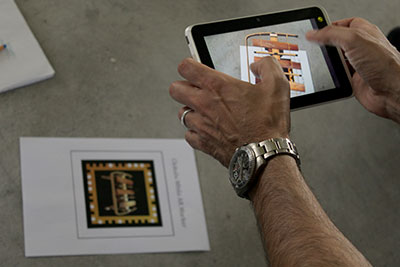
This technical demo and the concert presentation feature the creative aspects and technical research behinde the Timbila instrument of the Chopi people (Mozambique), which resembles a wooden xylophone. The project merges European and African Cultures throghout the instrument and the use of game audio and composition, by combining real and 3D game-engine-physics models of timbilas. The conference showcase includes a concert perfomance of “Xi” for live timbila and electronics by Ricardo Climent, performed by world-leading percussionist Miquel Bernat (timbila) and a technical demo of 3D virtual timbila models constructed by ‘Manusamo & Bzika’, an interdisciplinary group created by Manuel Ferrer Hernández (visual artist) y Alena Mesarosova (architect), specialised on Augmented Reality (AR) and 3D modelling. The technical presentation includes two 3D timbila models, the Chikhulu (bass with 3 keys) and the Sanje (18 keys), alongside a real Dbinda (baritone timbila). Its current sonic typo-morphology includes sample-based recordings and transformations of the instrument which are triggered via the gameengine’s interactive system. New physical models of the instrument will be implemented shortly using Climent’s outcomes from the NESS-project in Edinburgh.
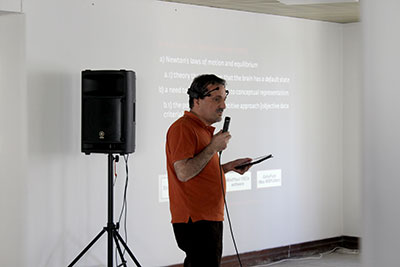
In this paper we propose an approach towards real-time representation of brain data using a virtual physics engine built in the Max MSP/Jitter graphical programming environment, and with the real-time raw Emotiv EEG BCI signal. Firstly we summarize about the brain as an electric phenomenon and as a perpetually active system dependent of an environment. Secondly we describe methods of representation of these phenomena in historical contexts such as science and art. We then establish a conceptual relationship between brain’s phenomena and Newton’s laws of motion and equilibrium. Finnaly we discuss potential gaps to be fulfilled and propose and describe EshoFuni.
The following paper details a research tangent explored within the scope of a larger project exploring a new method of interfacing the author has termed biokinetic: A biokinetic interface is a new form of dynamic and ever changing device that enables instrumental mediation between one or more users and an electronic component.
This research project employs an audio media player as the vehicle for validating the concept. In order for this interface to act in a nominally universal manner, the interface itself is visually abstracted, with the intention that anyone may approach the device and sense how to use it, and intuit what is happening, without recourse to agreed-upon historical symbols such as the play triangle, and the stop square.
Abstracted form would appear to have no underlying logical inference from which users can navigate the system, however in prior work, the author provisionally demonstrated – that for certain types of music at least – people appear to have a consistent and quantifiable abstracted visual language associated with specific music. It is the author’s intent to use this visual language as the basis for interfacing.
A performance work, Sound Choreography <> Body Code is introduced, which connects live coding and live choreography in a feedback loop of influence. Both the practice and the discussion of the work raise issues in coding, choreographic scores, and live performance through an exploration of feedback, interpretation and technological mediation of sound and movement in live coding environments. It suggests a model for interpretation of scores that allows for different approaches to scoring and interpretation in live performance settings and proposes how mutable scores differ in the instructional language within Sound Choreography <> Body Code.
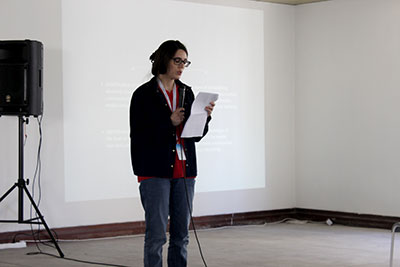
This poster presents the problems that led to the development of a news aggregator that allows users to explore the political information distributed by the media. Through the study of techniques for Natural Language Processing, interaction design, information visualization and the analysis of case studies, the research presents the first ideas prototyping features to implement in the aggregator. The ongoing research within the Doctorate in Design, at the Universities of Aveiro and Porto, aims to bring citizens closer to and more interested in political matters.

This paper documents a project focused on the use of rules as a structuring element of systems and on promoting a playful interactive experience as a strategy for the creative exploration of those systems. The project contemplates the application of computational principles to physical space through the mediation of human execution. It makes reference to Game of Life (Conway 1970) and Reverse-Simulation Music (Miwa 2002) as case studies: two opposite poles that illustrate both human and machine execution through procedural simulation and its reversal. Our approach is based on a practical exploration of strategies analogous to both examples. It aims to contribute to an understanding of software code as a creative field inside and outside the computer.
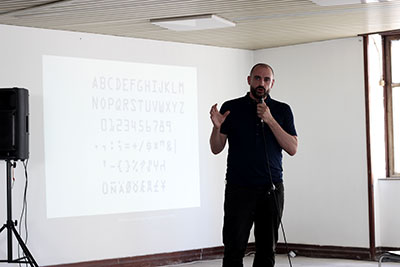
This paper considers the impact that software is having upon typographic principles and practice, and how the conventions of typographic communication are being transformed. Inspired by the possibilities of programming many typographers have begun to work more closely with code to generate designs, facilitate production, or organise layouts. However, the very functionality of code often serves to veil its aesthetic attributes.

This paper documents WindChime, a database oriented, web-driven audio-visual installation. In essence, two complex dynamical systems are interfaced, driven by the principle of ‘influence’ rather than ‘control’. Live weather activity in the world, intensity and direction of wind energy, is interfaced with a distributed particle system. Particles interact and, in turn, condition the behaviour of a self-running non-linear audio synth. We address the challenges of mapping and sonification including the aesthetic issues involved. It is suggested that the intricate interplay of the two systems may provide for a rewarding aesthetic experience.
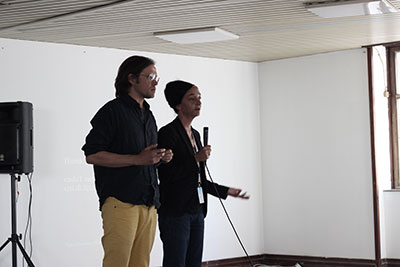
TimeMachine is a mobile phone application which aims to capture the elasticity of time experienced in everyday life and translate it into a meaningful image. The practical goal of the project was to devise a computational system to infer personal temporal relations, and create a visual interface to evoke an understanding of the experience of temporality for its user. The challenge was to concretise our views on the ambiguity of quotidian events –– time-based occurrences at the intersection of space and time ––, and to express them as a piece of freeware people could use to transform the reality of lived experience into a visual form.
M.M.M.M. is a generative sound and visual installation developed as a temporary exhibit for the Puppet Museum of Porto. It leans on the history of the museum and of the company that created it, the Puppet Theater of Porto, and develops a distributed sound composition with generative characteristics, built from sound recordings created through the manipulation of puppets and scenic objects from the archives of the company.
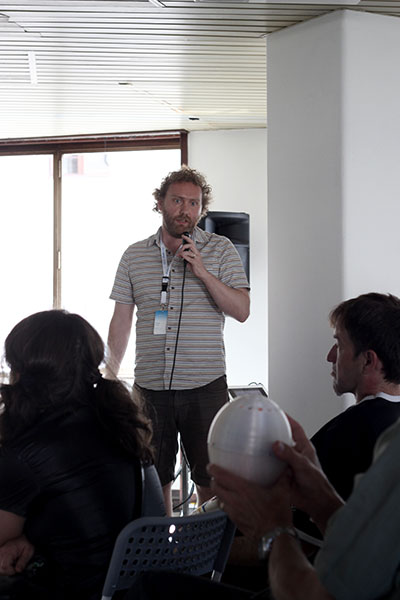
In the work Contact, the categories of performance device, loudspeaker system and compositional structure are jumbled and merged: the members of the audience are invited to be a part of the piece, and find themselves holding in their hands the loudspeaker system itself, which they can interact with via physical and digital affordances. A population of 10 “sound balls” is distributed amongst the performance space. Each ball contains a small WiFi–enabled computer, with loudspeaker and sensors (accelerometer and gyroscope).Following Bown et al. (2013), the balls can be ‘live coded’ from a host computer, running synchronised realtime generative audio software that incorporates the sensors’ activity into the sonic behaviour. They are fully portable and interactive, and are encased in generatively designed, digitally fabricated “elastoplastic” shells by architects reinhardt_jung.
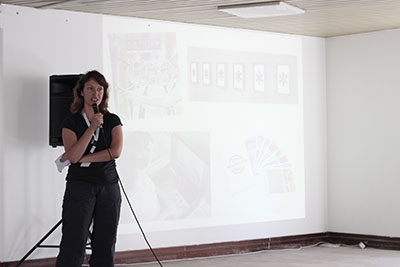
Scamming is a global phenomenon and victims can be found everywhere with no difference in gender, age or race. To persuade the victim into paying money upfront, the scammers create story worlds with get rich quickly schemes. The different narratives are situated in the grey area between reality and fiction (Hotz-Davies, 2011). These stories reflect the dystopian side of computer mediated communication where the Internet enables a world of false representations, abuse of trust, humiliation and desperation for opportunities.

The study documented in this paper aims to explore the creative potential that is inherent to the notion of transmutability of digital data. It begins by addressing the topic, discussing its principles and possibilities, while also examining the diverse approaches and practices that it encompasses. Based on these guidelines, we develop a project as a practical illustration of the topic, outlining a methodology that provides a starting point for further creative explorations of the concept. This study suggests the expressive and communicative potential of audiovisual languages that creatively explore the inherent mutability of digital data.
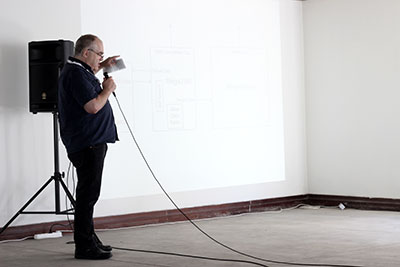
XEPA anticipates a future where machines form their own societies. Going beyond mere generative art, future machines will exhibit artistic creativity with the addition of artistic judgment via computational aesthetic evaluation.
The XEPA intelligent sculptures create animated light sequences and sound. Each XEPA “watches” the others and modifies its own aesthetic behavior to create a collaborative improvisational performance.
No coordination information or commands are used. Each XEPA independently evaluates the aesthetics of the other sculptures, infers a theme or mood being attempted, and then modifies its own aesthetics to better reinforce that theme. Each performance is unique and widely varied.
Babel’s Monkeys is an art work by Luís Sarmento Ferreira that consists on the cyclical rewriting of the biblical episode of The Tower of Babel (Genesis 11:1-9 –King James Version) using words from the real-time stream of Twitter public feeds. The work is presented on a wooden plinth with a built-in monitor on its top face. The object evokes both the shape of a pulpit or lectern and the one of a reading table with a book rack. This relates to the religious nature of the text being displayed in the monitor and to the influence of Jorge Luis Borges’ The Library of Babel to this work.

Drawing Sounds is an interactive installation that explores the translation of drawings into sounds. This custom system provides to the audience an immersive and acoustic experience resulting from light drawings. The incident light is momentarily absorbed by phosphorescent ink contained in the canvas surface. These reminiscent traces of light are then translated into sounds, allowing the users to create and experience their own sound compositions.
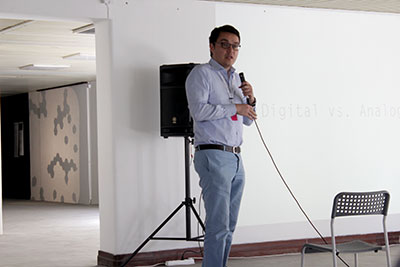
Glitcher is glitter for glitch: tiny pieces of colored material used for glitch–like decoration. Not only glitcher is nice to look at and fun to play with: it raises interesting questions on the nature of glitch in visual art.
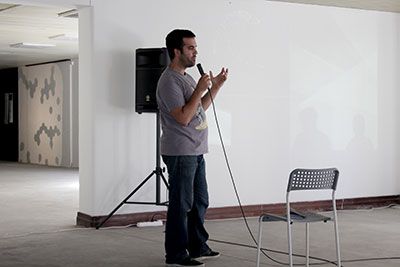
“Non Human Device #002” is part of series of interactive installations where experimental audiovisual devices/instruments are explored. In this installation the audience interacts with sound and vision content through a gesture based interface. By moving the hand over a device the user manipulate in real time a three dimensional virtual creature and interacts with the sound generation. It is an interactive system in the borderline between an exploratory sound and vision instrument, an art installation and gaming experience.

This art and design project is simultaneously a product and a provocation. By producing the NeoLucida — a modern reinterpretation of the camera lucida — we are stimulating interest in media archeology, art history, and the long relationship between art and technology. After an overwhelmingly successful crowdfunding campaign, the NeoLucida went out to almost 15,000 users. What happens when that many people start drawing like they did in the 19th century? What happens when thousands of people look at drawing differently? And what happens when they adapt it to their own, 21st century uses?
The “x factor" in xCoAx – that spellbinding glue that holds arts, computation and communication together – is what makes this conference and its participants unique. The global intertwingling of social, economic, political, environmental and technological worlds leaves us facing a host of complex and urgent issues. To address these contemporary challenges we have chosen to design a scenario workshop for the xCoAx edge-dwellers. We draw on participants’ shared imagination to search for possible (and preferable) futures at the interstices of the “x factor”, moving beyond disciplinary boundaries towards the elusive Third Culture.
In this day-long workshop we will explore the past, present and possible futures of the "x factor" by examining what we know and assume, but also what is unknown to us at the moment. Well understood foresight techniques, including scenario building and horizon scanning, will be introduced alongside more experimental methods bricolaged together by FoAM's experiential futurists into a process that will be premiered at xCoAx.
We will guide participants to co-create a set of possible future scenarios – short, evocative stories that encourage the participants to let go of the status-quo and imagine what could be otherwise. The purpose of the scenario building is not an attempt to predict the future, but to create a more dynamic relationship between the present moment and the possibilities it contains, to sift through cultural myths, examine macro-trends and better understand where we are now to see more clearly where we might want to go.
After the workshop, the Future Fabulator's team (and other willing participants) will translate one or more of the scenarios into an experience prototype that we call a "future pre-enactment" – a hybrid between a theatre game, speculative fiction and insight meditation. During the pre-enactment, guests will be guided through an experience of what it might be like to live in different "x factor" futures. The pre-enactment will take place on the last evening of the conference and last up to one hour. There can be no spectators, only participants.
The scenario workshop and pre-enactment are a part of the European project Future Fabulators, co-ordinated by Time's Up in Austria, with FoAM (Belgium), M-ITI (Portugal) and AltArt (Romania) as co-organisers and xCoAx among several associated partners.
